Lyons W.C. (ed.). Standard handbook of petroleum and natural gas engineering.2001- Volume 1
Подождите немного. Документ загружается.

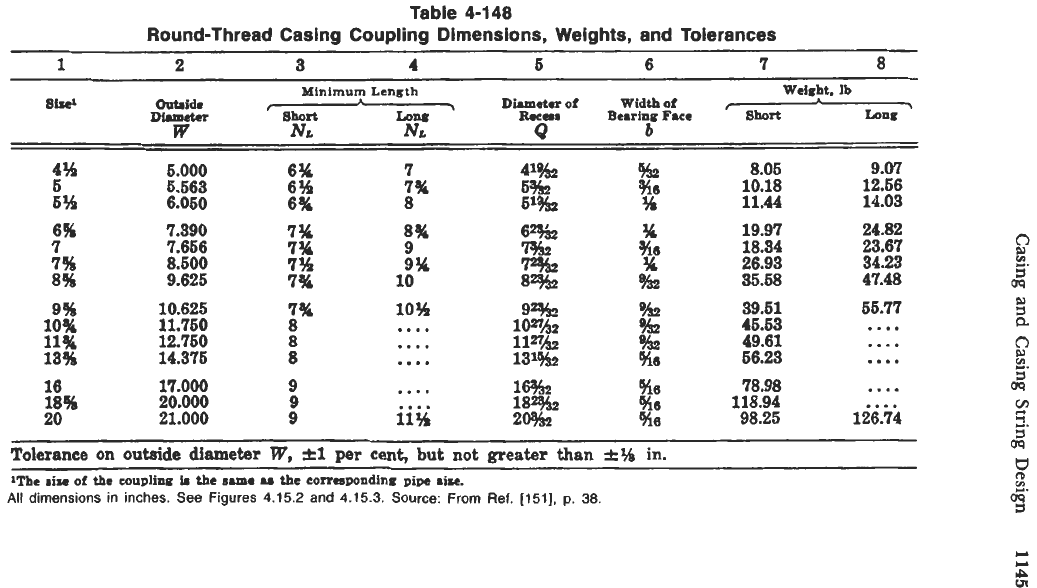
Table
4-148
Round-Thread Casing Coupling Dimensions, Weights, and Tolerances
1 2
3
4
6
6
7
8
Minimum
Length
Weight, lb
ollbide
Dimnetor
of
Width
of
Y
\
Di.mct+r
short
Lono
Rocem
BearingF.ec
'
Sho*
Lon.
8W
W
NL
NL
Q
b
4%
6
6%
5.000
6.663
6.050
6%
6%
6%
7
736
8
8.05 9.07
10.18 12.56
14.03
11.44
41%
%
6%
S1%
%
#6
39.61
66.77
E
6.
n
46.53
....
49.61
....
0
66.23
....
9% 10.625
7%
10% 9%
%
10%
11.750
8
....
1027h2
9%
11%
12.760
8
....
ll*!
9x2
13% 14.376
8
....
131%
%S
16 17.000
9
18%
20.000
9
20 21.000
9
%0
78.98
....
118.94
....
....
1%
#S
iiii
2%
%0
98.25 126.74
18%
5
09
?
U
D
05.
2.
09
Tolerance
on
outeide diameter
W,
fl
per cent,
but
not greater
than
k36
in.
1Thc
iixe
of
the
coupling
in
the
sune
M
the
corresponding
pipc
Dim.
All
dimensions in inches.
See
Figures
4.15.2
and
4.15.3.
Source:
From
Ref.
[151],
p.
38.
=r
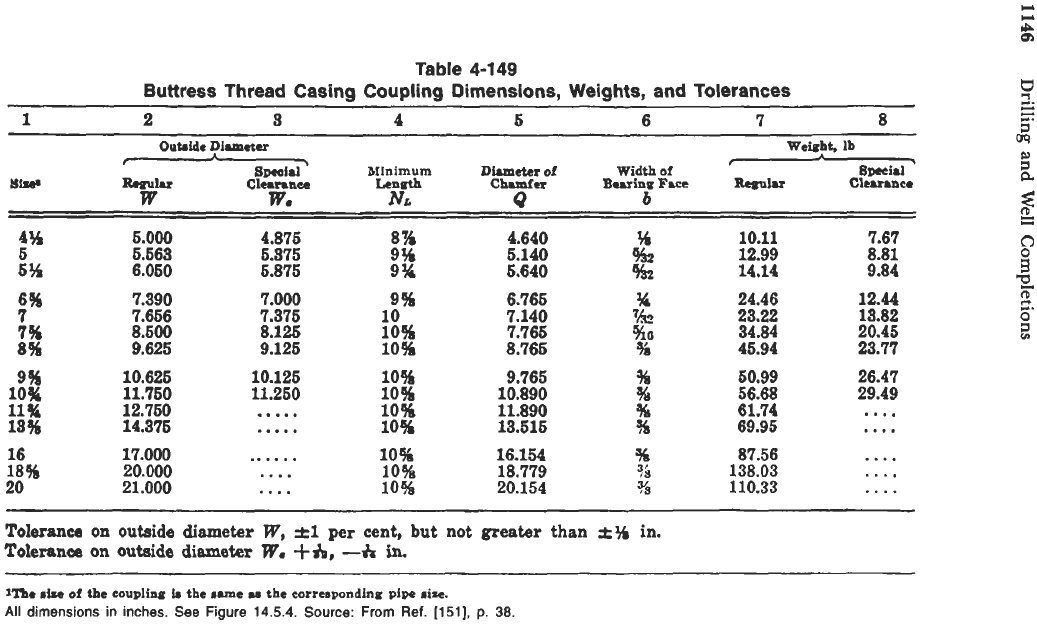
Table
4-149
Buttress
Thread
Casing Coupling Dimensions, Weights, and Tolerances
1
2
3
4
5
6
7
8
Outride
Diameter
Weight,
Ib
r
r
7
sWci.1’
Minimum
Diameter
of
Width
of
8wci.l
I-
R.pulu
Cle.t.ncs
Lm.th
Chda
BssrinoFace
Resular
Cluranec
W
W,
NL
8
b
4%
5
5%
6%
7
7%
8%
9%
low
11
94
13%
16
18%
20
5.000
5.563
6.050
7.390
7.656
8.500
9.625
10.625
11.750
12.750
14.375
17.000
20.000
21.000
~-
4.875 8%
5.375 9%
5.875 9%
7.000
9%
7.375 10
8.125 10%
9.125 10
%
4.640
5.140
5.640
6.765
7.140
7.765
8.765
%
E
10.11
12.99
14.14
24.46
23.22
34.84
45.94
......
10%
....
10%
....
10%
9.765
10.890
11.890
13.515
16.154
18.779
20.154
50.99
56.68
61.74
69.95
87.56
138.03
110.33
~
7.67
8.81
9.84
12.44
13.82
20.45
23.77
26.47
29.49
....
....
f...
....
....
~
--
~ ~~
-
Toleranca
on
outside
diameter
W,
f1
per cent,
but
not
greater than
&%
in.
Toleranca on
outside
diameter
W#
+h,
--k
in.
8
z
4
5‘
3
v,
1Tb.
size
of
the
coupling
h
the
same
ma
the
corresponding
piw
size.
All
dimensions in inches.
See
Figure
14.5.4.
Source: From
Ref.
[151],
p.
38.
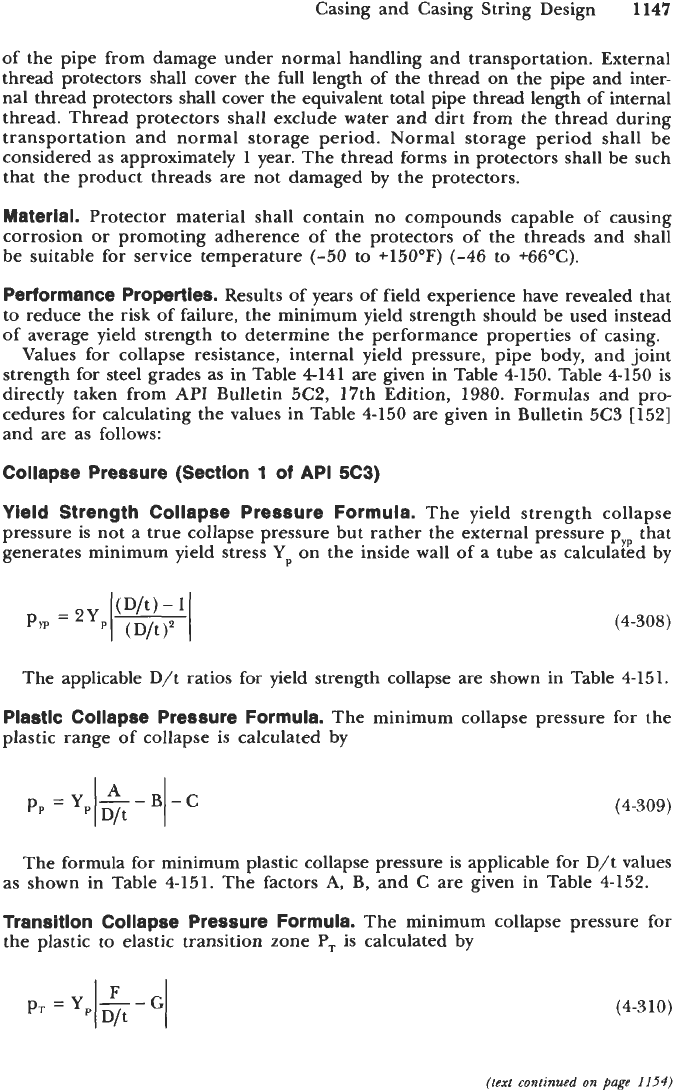
Casing and Casing String Design
1147
of the pipe from damage under normal handling and transportation. External
thread protectors shall cover the full length of the thread on the pipe and inter-
nal thread protectors shall cover the equivalent total pipe thread length of internal
thread. Thread protectors shall exclude water and dirt from the thread during
transportation and normal storage period. Normal storage period shall be
considered as approximately 1 year. The thread forms in protectors shall be such
that the product threads are not damaged by the protectors.
Material.
Protector material shall contain no compounds capable of causing
corrosion or promoting adherence of the protectors of the threads and shall
be suitable for service temperature (-50 to +150°F)
(-46
to
+66OC).
Pertormance Properties.
Results of years of field experience have revealed that
to reduce the risk of failure, the minimum yield strength should be used instead
of average yield strength to determine the performance properties of casing.
Values for collapse resistance, internal yield pressure, pipe body, and joint
strength for steel grades as in Table 4141 are given in Table 4-150. Table 4-150 is
directly taken from
API
Bulletin 5C2, 17th Edition, 1980. Formulas and pro-
cedures for calculating the values in Table 4-150 are given in Bulletin 5C3 [152]
and are as follows:
Collapse Pressure (Section
1
of
API 5C3)
Yield Strength Collapse Pressure Formula.
The yield strength collapse
pressure is not a true collapse pressure but rather the external pressure p,, that
generates minimum yield stress
Y,
on the inside wall of a tube as calculated by
(4-308)
The applicable D/t ratios for yield strength collapse are shown in Table 4-151.
Plastic Collapse Pressure Formula.
The minimum collapse pressure for the
plastic range of collapse is calculated by
(4-309)
The formula for minimum plastic collapse pressure is applicable for D/t values
as shown in Table 4-151. The factors
A,
B, and C are given in Table 4-152.
Transition Collapse Pressure Formula.
The minimum collapse pressure for
the plastic
to
elastic transition zone
P,
is
calculated by
(4-3 10)
(text continued
on
page
1154)
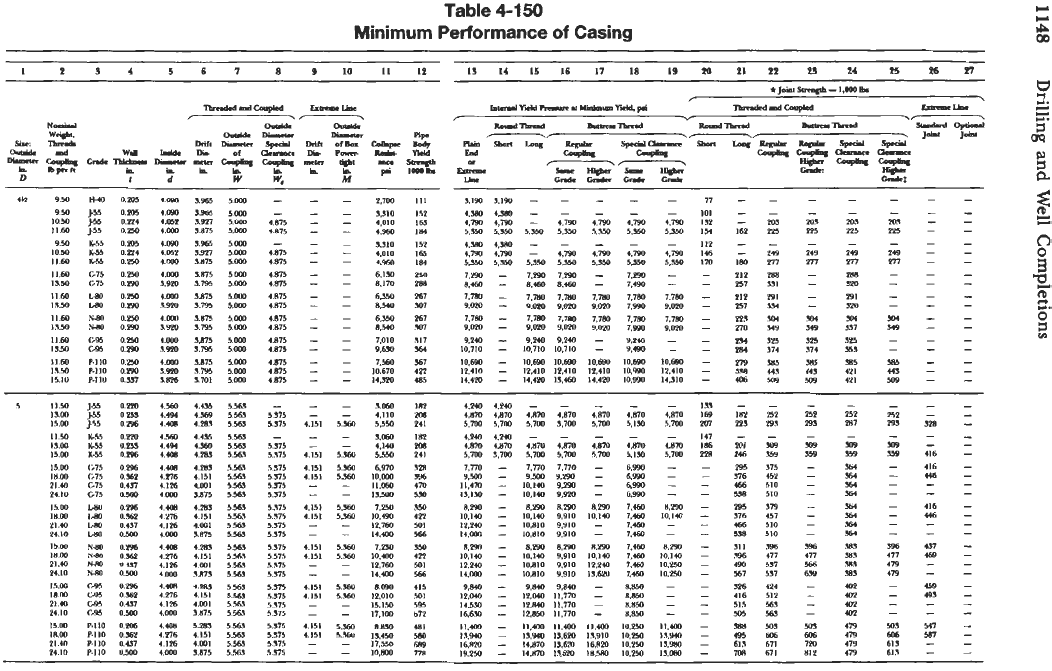
Table
4-150
Minimum Performance
of
Casing
KHI
0.205
J.M
n.m
c
E
KJ5
0.m
W
0.14
I.%
awl
c75
0.m
ua
0.m
um 0.250
um
om
~75
om
LBO
am
om
ras
um
ciw
0.m
p.110
om
PllU
0.u7
4.m
ssf.5
5.m
4aa
82x6
3.m
4.052
3.927
5.m
4.m
3875
5.m
4.090
1.56
5.m
1.14
19n
5.m
4.m
3B75
5m
4.m
5.871
5.m
4.m
a875
5.m
3920
3.m
5.m
4m
3n75
5.m
3940
3.795
5.m
4.m
5875
5.m
4.m
3875 5.m
3950
3795
5.m
3.m
3.701 5.m
s,9m
8.795
5.m
5950
am
5.m
-
-
4.875
4.815
4.875
4875
4.815
4.815
4.875
4875
4.875
1.875
4.875
4.875
4
675
,875
-
4.875
Y.7M
111
5110
1.w
4,010
I69
4.w
184
3,310
15Y
4.010
I69
4,960
I84
6.IYI
250
8.170
263
hno
967
8.540
307
6.W
967
8.W
N)7
7.010 317
9,630
16)
7.m 367
10.670 452
iem
MS
3,1903.190
- - -
-
4.am4m-
-
- -
4.m
4.790
-
4.m
4.m
4,790
5.350
5.350
5.m
5.w
5,w
5,160
4.m
4,sw
-
-
-
-
4.M
4.790
-
4.m
4.m
4.790
5.m
5.s50
5.350
5560 5560 5560
1,m
-
7.m
7.w
-
7.m
8,160
-
n.160
8.-
-
7,490
7.180
-
7.m
7.m
7.m 7.7m
9.040
-
om
9.010
9.010
7.m
7.780
-
7,711)
7,711) i.7~
7,111)
9.m
-
9.m
9,040
9,nm
7.990
9,240
-
9.240
9.210
-
9.240
10,710
-
iq7w
IO.?IO
-
9.W
1n.m
-
10.~0
10.m
IOBBO
10.m
IP.~
-
12,410
IP.IIO
IP,~IO
1o.990
1v.m
-
11.4m
15.160
iI.4m
1o.990
5
1I.Y)
Ism
ISM
1I.u)
1s.w
15.00
I8M
21.40
24.10
I5m
18M
Yl.10
%.IO
ISM
I8
m
21.40
15.W
18
00
21
40
24
10
ism
24.10
ikm
18.m
21
10
PI
10
n.m
0
253
0.296
0.m
u25s
OM
02%
0.437
n.%2
am
n.m
om
np96
n
u7
a296
n
%P
0.437
om
0162
04S7
0362
0.m
45m
4.435
1%:
-
-
-
3m
4.49
4.569
5.M
5.315
-
-
4.110
4.108
4.283
5.m
5.315
4.141
5.160
5.550
4.m
,.4s5
5565
-
-
-
1060
4494
435%
5.M
5.875
-
-
4.140
4.m
4.281
5.5f.5
5375
..I51
5.550
5550
IW
4283
5.m
5.375
1.151
5.160
4970
4.776
4.151
s.5~
5.375
I
111
5560
lo.m
4.126
4.wr
5.555
5375
-
-
11.M
MU
$871
5563
5.375
-
-
IYW
1-
4.283
5.553
5.375
4.151
5,160
7.W
1.276
4111
5.%* 5.375
4
151
5.160
10.490
4.196
4.Ml
5.165
5.s75
-
-
12,760
4.m X875
5.m
5315
- -
I4.M
4.-
428)
5.M
5375
4.151
5.560
7.m
4.776
4.151
5.563
5315
4
IS1
5.m
10.400
4.196 4m1
5.Sm
5.375
-
-
12,760
4.m
3.873
5.m
5.375
-
-
14.m
4.W
4.283
5.563
5975
4.151 5.550
8W
IIp6
4.001
5,.&St
5375
- -
15.150
4.m
$175
5,543
5'175
-
-
17,100
,776
4
151
5.563
5.375
4.151
5.160
IZ,OIO
133
-
IW
4,240
4.940
-
- -
-
-
'm
4.870
4,870
wo
4.870
4.870
4.m
4,870
IH
in2
241
5.m 5.7M
5.7W
5,7M
5.700
5.130
5.700
Om
523
IW
4m
4z40
-
-
-
-
-
147
-
sin
4.m
ran,
4Blo
4.m
4m
am
ww
ins
mi
241
5,700
5.7M
5,700
S.mO
5.7M
5.130
5,lM
PSR
246
7.770 1.770
-
6.990
- -
295
376
I?R
7.770
-
s6
9.m
-
sm
9.m
-
4990
-
-
49%---166
6,953
- -
3%
470
11.470
-
I%IUL
9990
-
Yo
I3,IsO
-
10.140
Y.920
-
.E4
8.m
-
n,m
8.290
8.M
7,-
n.m
-
235
122
1o.140
-
In.iu?
9.910
in.11o
7.m
1u.110
-
S76
501
12.~40
-
io.810
9.910
-
7,160
-
-
166
566
14.m
-
iomn
9.yin
-
7.160
-
-
338
uo
8.2%
-
8,290
8.m
8.m
7,160
8.M
-
311
422
10,110
-
IO.IC
9,910
io.110
7.160
in.IH)
-
ms
501
12,210
-
ioain
9.910
12.440
7,m
10.m
-
.(90
566
14.m
-
in.8w
9.910
w<m
7.160
IWW
-
567
9.840
9.840
-
w--m
8.W
-
-
416
8,850
-
-
515
415
9,840
-
501
12,040
-
12.MO
11.170
-
%%
I4b.W
-
12.840
11.770
-
814
16.f.w
-
12.w
11.770
-
nm
- -
50)
------
252
252
252
252
-
-
y9~
m
287
293
s18
-
_-----
¶naoasa--
Wu9
SW
M416-
375
-
%4
-
416
-
452
-
16)-446-
SIO-SI
---
510
-
16)---
379
-
X4
-
416
-
+57
-
X4
-446-
16)---
SI---
510
-
3% 3%
283
3%Ul
-
177 177
383
477
169
-
557
566
38s
479
-
-
5s7
6%
28s
419
-
-
w-uIp-4m-
512
-
4a-w-
w9-m---
563
-
w---
Ynm479Ynm-
M6606479606M-
671 720 179
613
-
-
671
niy
419
613
-
-
510
-
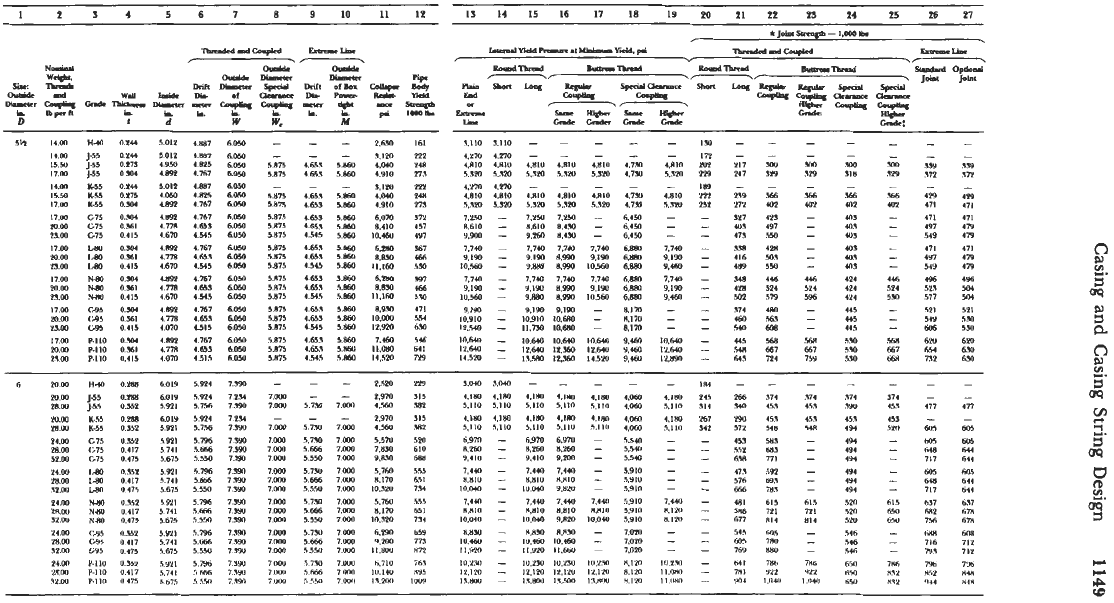
1
I
S
4
5
6
1
8
9
IO
11
19.
IfI4151617
I8
19W21P
M
24
25
2627
*J&~-l#Wlh
r
-.
I4W
J45
0.144
1.012
4887
6.050
-
-
-
1.lB
922
15.50
J.55
0973
4.Y.W
4825
6050
5875
46.M
5W
4,W
Ye
l4.m
K.55
0.2H
5.012
4.637
6.050
-
-
-
3,120
!ZYY
17.m
~45
ow
4.m
4.7fi7
6.m
id75
4-8
5.860
4.~1~
271
IUO
&IS
0.175
~.w
I.RPL
&as
5n75
4.m
5m1
IMO
PW
17.m
K-
0.1~1
~w1
1.767
COW
58%
4.m
5660
4,910
zn
17.m
c75
om
4.w
<.7e.7
6.w
5.875
,.as
5.860
6.0~
572
BW
c75
a.m
4.778
1.655
6.050
5875
4.651
5860
8,410
117
2307
G75
0.415
1.670
4545
6050
5875
4.545
SBM
10.460
4Y7
I7
W
lam
m.m
0204
4.m
4.767
buy)
5.875
4.65s
5.860
6,Wl
0.w
4.718
4.65s
&OM
u05
4.653
5860
88Yl
0415
4.670
1.545
b0.W
5.875
4.545
5.860
II.IM
om
4.m
4x7
fi.asn
5.875
4.653
SBM
hm
ow
4.77~
,&s
LOW
18%
4.6%
1.860
8.8~1
0.411
4.670
454.1
605'3
5.875
4.515
5860
II.1M
0.304
4.BP
4767
6.050
5.875
4.651
5860
8.9.W
(1.541
4.778
+.&1
6.050
5875
4.653
5BM
l0.m
0.415
4070
4.515
60%
5.875
4.5.5
5.860
IY.~
0.1~1
4.m
4.767
6.m
5875
e.&*
5.860
7.w
0.541
4.778
+.a1
6.m
5.875
4.6~3
5.~6~
ii.aw
011s
4.070
451s
6.05'3
5.~75
4.545
SBM
14.sm
%7
4f4
SYl
*n
4e6
530
171
554
hW
546
MI
N9
4.m
4.m
-
- - -
-
189
-
-
4.810
4nin
4.810
inlo
4810
4.m
4,810
rn~
m
s(h
5.3~
5.m
5320
5320
sm
4.7~0
r.m
152
In
cm
6,450
-
-
YY7
4.0
44.W
-
-
401
497
7.l.w
-
7.w 7.15'3
-
8.610
-
Ub10
8.450
-
9.W
-
9.m
8.4%
-
6.4M
- -
473
.E4
7.740
-
7,740
7.740
7.740
fim
7.740
-
3%
4211
9.190
-
9.190
US3
9.lW
6bRl
Y.1W
-
416
503
I0.W
-
9.W
8990
1-
6.W
9,460
-
4UY
550
7.740
-
7.740
7.7M
7.740
6.m
7s740
-
SM
446
9,190
-
Y.IW
8,990
9.IyU
6.W
9,190
-
428
524
1u.m
-
9.m
8.p911
105M
6,880
9.4611
-
.m
14
Y.IW
-
Q,IW
9.1~0
-
8.170
- -
174
UYI
ia.yiu
-
in,wo
10.6~
-
x.17~
- -
um
.56(
IP.'*(l
-
II.7YIIO.Mo
-
8.170
-
-
sa
um
1O.W
-
1o.w
I0.6M
lorn
9.w
l0.W
-
445
m
I2.W
-
11,610
11.363
IP6a
Y,IM
1Y.W
-
.Mi
667
i<.m
-
IY.~
14.m
14.m
9.4611
12.m
-
MY
724
m
123
366
(M
-
14.5
524
5Y6
.m
a7
7rJ
446
524
5W
.5Fd
f67
en
1%
172
-
423
471
471
IW
549
471
4Y7
549
4%
SI3
577
521
5w
uJ6
620
rn
712
n
g
5'
09
E
a
n
5'
09
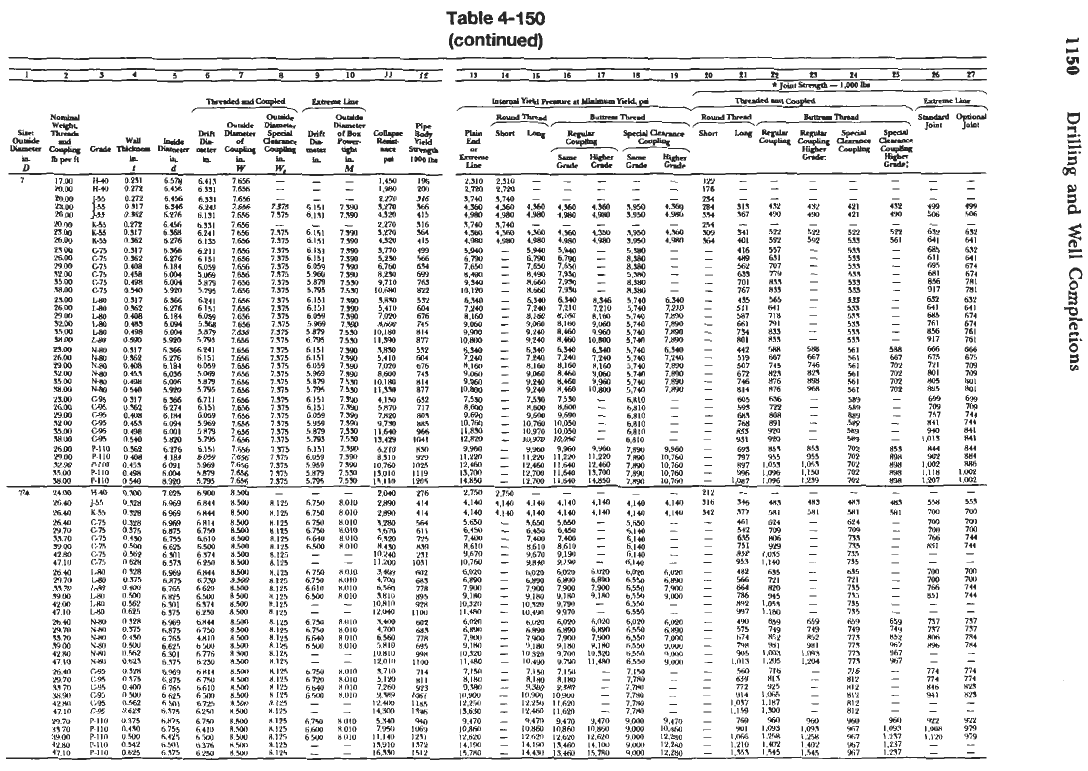
Table
4-150
L
-
6.151
6.111
6.131
6.151
6.059
1.988
1.879
1.791
6.151
6
I51
6.059
1969
5
879
6
795
h
IS1
6
IS1
6
059
1.988
5
879
5
791
6
151
6
111
6
055
5955
5
879
5
79s
6111
6
039
s
919
5
1179
5
795
-
-
ti
7YJ
6.73O
6
750
6.7W
fiW
fi..m
6
7.w
6750
6.610
6.W
-
-
-
-
6.7.W
6
7%
6.W
61U1
-
7.393 5,770
19)
7.390
5,430
166
7390 6.7M
6%
7590
REM
699
7590
9.710 7N
7330
1n.m
822
7.m
3,nw
5.92
7590
1.410
604
7.390
7,040 676
7.W
N.hm
715
71.W
10,180
814
7sv)
11.190
877
7990
J.890
5.92
7390
5.410
Nu
7390 7,020
b76
7390
8,Mo
741
7.530
II,SW
877
7590
4,154
632
7.590 1.870
717
7590 9,730
ens
7.590
II.wo
966
7390
6.210
8W
73911
8,510
Y'O
7S30
13.010
1119
-
2.040
27b
8010
2,634
111
8010
2.890
414
8.010
x2.280
.w
8.m
wrn
611
8010
6.m
72s
801"
8.430
839
-
1n.2~
YW
-
II~
10.91
7.5~
io.1~0
ni(
7590 7.840
mi
7590
15.449
in41
7390
10.760
lorn
7.550
15.~0
1m5
R.010
s,m
Hn
%"IO
4.7W
6115
""10
ti3m
778
8010
)mu
BYS
-
IO,RIO
gzx
-
II.UN
iiim
8.m
%urn
MIY
soin
i.810
ws
-
n.mn
II~
win
3.7111
714
""in
7.2~
~23
-
IP,~
118s
UOlU
4,700
M5
R
010
6.560
778
-
1U.BIII
896
R0IU 5,120
811
B",,)
Y.IX9
1061
-
14.500
13'46
""lo
5.344
qN
80l"
7.95"
In69
801"
11,1411
1231
~ 13,910
I572
-
16.930
1112
E
-

8.097
7.921
7.825
8.097
7.921
7.825
7.825
7.725
7.625
7.511
7.825
7.725
7.625
7.511
7.825
7.725
7.625
7.511
7.825
7.725
7.625
7.531
7.725
7.625
7.511
7.m
7.796
7
700
7.972
7.796
7.700
7.700
7.600
7.300
7.386
7.700
7600
7
500
7.386
7.700
7.600
7.500
7.386
7.706
7.m
7.500
7.386
7.m
7.500
7.386
D
Id
w
w,
M
&is
28.w
H-W
0304
8.01'1
7.892 9.625
-
-
-
1.640
318
32.00
H-Ul
0.352 7.921 7.796
9.625
-
-
-
2.210
366
24.w
32.00
36
00
24.00
32.00
36.00
36.00
40.00
44.00
49.00
36.00
40
00
44.00
49.00
56.00
40
00
44 00
49.00
.96.00
40.00
44.00
49.00
40.00
4900
44.00
9%
9.625
9.625
9.625
9.625
9.625
9.625
9.625
9.625
9.625
9.625
9.625
9.625
9.625
9.625
9.625
Y
625
9.625
9.626
9.625
9.625
9.625
9.625
9
625
9.625
9.625
-
-
9.125
9
125
9.125
9
125
9.125
9.125
9.125
9.125
9.125
9.125
9.125
9.125
9.125
9.125
9.125
9.125
9
125
9.125
9.125
9.125
9.125
9.125
9
125
-
-
7.700
7.700
7.700
7.700
7.700
7.600
7.500
7.386
7.700
7.MM
7.500
7.386
7.700
7.m
7.500
7.386
7.700
7.600
7.500
7.386
7.600
7.500
7.386
-
-
9.120
9.120
-
Y
120
9.120
9.120
9.120
9.m
y.120
9.m
9.120
9
120
9.120
9.120
9.120
9.120
9.120
9.120
9.120
9.120
9.120
9.120
9.120
9.m
1,370
2,530
3.450
1.370
2.590
3,450
4,020
5.350
6,680
8.200
4,100
5,520
6,950
4.100
5.520
6,950
8,570
4,360
6,010
7,730
9.690
6,380
R,400
in,m
n.570
581
503
568
381
503
775
867
957
1059
827
925
in21
1129
827
925
10'21
1129
982
1098
1212
1341
1271
1404
1553
560
233
-
-
-
- -
-
-
2.470 2,470
-
-
-
.-
-
2,8M
2864
-
-
-
- -
279--
-
-
-- -
2.YB
3.950
4.403
2.950
3,930
4,460
6.090
6.854
7.610
8.480
6,490
7,.w
u,im
9,040
7,300
8,120
9,040
7.710
8.670
9.640
10,740
10,040
11,160
6.490
12.430
2.950
- - -
3,930
3.9M
39.W
$,a0
4,w
4.460 4.460
4.m
94611
-
-
-
i:Y%
3,930 3,950 3,930
4.460
4,460
4,w
4,4w
-
6.W
6.090
-
6,850
6850
-
-
7.610 7.610
-
-
6.490 6.490
-
-
-
nm
8.480
-
-
7,300
7.333
-
-
8,im
8.m
-
-
7,300
7,300 7,300
-
8.120
8,im 8.1m
-
Y,W
9.040
9.040
-
7,710
7,710
-
-
8.670
~.67n
-
-
9,640
9,640
-
-
in.o4o
10.040
iu,w
-
11.160
11.160
I1,IM)
-
12,430
12.450
12,430
-
9,040
Y.040
-
-
6.490
6,490
6.90
-
10.740 10,740
-
-
3.930
4,060
3,930
4.060
5.550
5,550
55m
5,550
5,900
5,900
5.m
5.900
5.900
5,m
5.900
5,900
-
7.010
i,nio
8.110
8,110
8,110
7,010
7,010
-
417
486
452
526
648
742
034
939
678
776
874
983
688
7RR
RR7
997
789
904
1.017
1.144
1,055
1,186
1,335
-
-
579
b54
690
780
847
947
1.046
1.157
e64
966
1.066
1,180
895
l,Wl
1.105
1,222
976
1.092
1,206
1.334
1.288
1.423
1,574
-
-
579
654
690
780
839
839
839
839
839
839
883
883
883
883
Y27
927
927
927
1.103
1,103
1,103
-
839
8x9
-
f.%
688
86(1
871
942
IM17
1.007
871
942
1.007
1,W7
917
992
I
,060
1
,060
963
1,113
1.113
1.240
1.326
1.326
-
871
1.042
-
6R6
688
869
R71
871
8%
886
846
871
886
886
886
917
932
932
932
963
979
979
979
1,165
1,165
1,165
-
40.00
cr75
0.395
8.835
8679
10.625
10.125
8.599 10
100
2;980
859
5.390
~
5,390
5,390
-
4.990
-
-
694
9%
-
926
-
975
975
934
-
975 975 776
1.016
-
43.50 c75 0.435 8.755
8.599
10.625
10.125
8.599
10.100
3,750
942
5,930
-
5.930
5,990
-
4.990
-
-
052
1.098
-
9.34
-
1,032
1.032
47.00 c-75 0.412
8.6~1
8.525
10.625
1u.125
8.525
1u.m
4,6511
loin
6,440
-
6,440
6.440
-
4,990
-
-
53.50
G75 0.545 8.535 8.579
10.625
10.125
8.379
10.100
6330
1166
7.450
-
7.430 7.430
-
4,~
-
-
993
1.257
-
9.M
-
1.175
1.053
40.00
UIO
0.995
8.835
8.679
10.625 10.125
8.m
10.1~
3,090
916
5.750
-
5,750 5.750
-
727 947
-
9.34
-
975 975
43.50
lA0
0.435
8.755
8
599
10.625
10.125
8.599
10
100
VI0
1005
6.330
-
6,330
6,330
-
813
1.038
-
934
-
975
975
89s
1,122
-
934
-
1.w
I,OYZ
4700
IAO
0.472
mi
R
525
10.625
10.125 8.525
io
100
4,750
1086
6.870
-
6.870
6,870
-
5350
IAO
u
545
8.535
8.379
10.625
10.125 8.379
io
ion
6,620
1244
7.930
-
7.930
7,930
-
40.00
vxn
0.395 R.R%
8
679
IO
fit5
10.125
8.53~
10.100
3.0~0
916
5.750
-
5.750 5.750 5.750
43.50
N~U
0.43.5 8.755 8.599
in
fi25
10.125
8.590
10.100
win
1005
6m
-
6,390
6,330
6.3.30
47.00
N-RO
0.472
8.681
8.525 10.625
10.125
n.m
moo
4.750
1086
6.m
-
6.870 6,8711
6.~10
53.50
N-RO
u..w5
8.535
8.379
10625
1n.m
8
IU.IUU
6,fizo
1244 7.~30
-
7,930 7.~50 7,930
1,047
1386
-
934
-
1.173 1,059
4000
G95
0395
8,895 X.679 10.625
10
125
R
10100
9,330
1088
6,820
-
6,820
6,820
-
43.50
GY5
043.5
R.755
8
599
10.625
10
125
R
loion
4,150
119%
7,510
-
7,510
7,510
-
47.00
CY5
0472 R.I1
8525
10,625
10
125
8
10.100
5.080
1239
8.150
-
8,150
8,150
-
5350
c.95
0545 ~.535 8379
10
10.100
7.230
1477
9.410
-
9.410
LJ.~
-
1,nm
1.458
-
4~50
P-IIU
0.435
8.755
8.5~~
IO
in.100
4.430
nni
R,~W
-
8.700
8.704 8.700
47.1~
P-IIU
0.472
n.mi
8.525
10
.525
IU.IUU
5,310
1403
9,440
-
9,440
9,440
9,440
7.310 9.440
-
iq 5o
uin
01545 8.535
8.379
in ,379
IU.IUU
7.930 1710
10.900
-
IO.WU
10.w
i0.9~0
7.310 9.970
-
L
c
01
b-
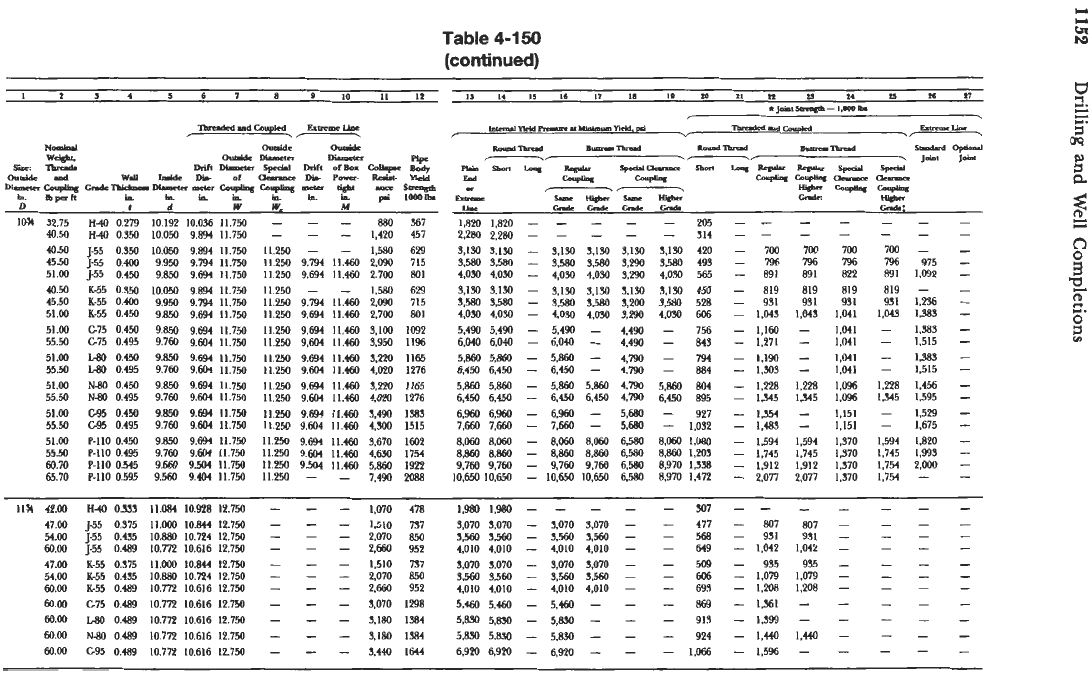
4050
J-55
0.359
10.050
9.894
11.750
11.250
-
-
1580
629
3,130
3,130
-
3,130
3.130
3,150
3,150
420
-
700 700
700
m
-
-
45.50
J-55
0.400
9.950 9.794
11.750 11.250
9.m
11.460
2.090
715
3.580
3580
-
3580
3580
3,990
$580
493
-
796mm
m975-
891
891
822 891 1.092
-
51.00 1-55
0.450
9.850 9.694
11.750
11.250
9.694
11.460
2.700
801
4,030 4.030
-
4,030 4.030
3.290
4,030
565
-
40.50
4550
51.00
51.00
55.50
51.00
55.50
51.00
55.50
51.00
55.50
51.00
5550
60.70
65.70
K-55
0.350
K-55
0.400
K-55
0.450
C75 0.450
G75 0.495
LBO
0.w
LBO
0.495
N80
0.450
K80
0.495
C95
0.450
C95 0.495
P-I10
0.450
P-I10
0.495
P-110
0.545
P-110
0.595
10.050
9.950
9850
9.850
9.760
9850
9.760
9.850
9.760
9.0%
9.760
9.850
9.760
9.m
9.560
9.694
11.750
9.794
11.750
9.694 11.750
9.694
11.750
9.604
11.750
9.694 11.750
9.604
11.750
9.694
11.750
9.604
11.750
9.694
11.750
9.604
11.750
9.694
11.750
9.604 11.750
9.m
11.750
9.404
11.750
11.250
11.250
11.250
11.250
11.250
11.250
11.250
11.250
11.250
11.250
11.250
11.250
11.250
Il2W
11.250
-
9.M
9.694
9.694
9,604
9.694
9.604
9.694
9.604
9.694
9.604
9.694
9.604
9.504
-
-
I1.IM)
11.460
11,460
11.460
11.m
11.460
11,460
11.460
11.460
11.460
11.460
ll.4@l
1I.W
-
1,580
2.090
2.700
3,100
3,950
3.0
4,020
3,220
4.m
3,490
4,300
3,670
4.630
5,860
7.490
629
3,130
715
3,580
801
4.030
1092 5.490
11%
6,040
1165
5.m
1276 6.450
1165
5.860
1276 6.450
1583
6.960
1515
7.660
1602
8,060
1754 8,860
1929
9.760
10.650
5.130
3580
4,030
5,490
6.040
5,860
6,450
5.860
6.450
6.w
7.660
6.860
9.760
10.650
8.060
3,130
3.580
4,030
5,490
6,040
5,860
6,450
5.860
6.450
6.960
7,660
8.060
8,860
9,760
10,650
3,130
339
3,290
4.490
4.490
4.790
4.790
4,790
4,790
5680
5.680
6580
rn
6.580
6.580
5,130
3580
4.030
-
-
5.860
6.450
-
-
8,060
8W
6,970
8.970
450
528
606
756
843
7%
884
804
895
927
1.038
1.080
1,ms
1,338
1,472
819
931
1,043
1,160
1,271
1.190
1.303
i,ns
1,345
1,554
1,483
1,594
1.745
1,912
2,077
819
931
1,043
-
-
1,228
1345
1,594
1.745
1,912
2,077
819
931
1,041
1.041
1.041
1.041
1,041
1,096
1.096
1.151
1,151
1,370
1.370
1,370
i.3m
819
931
1,043
-
-
-
-
1.248
1.345
-
-
1,594
1,745
1,754
1,754
1.2%
1,583
1.583
1,515
1333
1,515
1,456
1595
1529
1.675
1,820
1,993
2.ooO
-
111
42.m
47.w
54.00
60.00
47.00
54.w
60.00
60.00
60.w
60.00
60.00
H40
0.333
J-55
0.375
J-55
0.435
IC55
0.375
K-55 0.4%
K-55
0.489
G75
0.489
LBO
0.489
N40
0.489
J-55
0.489
1x5
0.189
11.w
1o.m
12.750
lI.wO
10.844
12.750
10.880
10.784 12.750
10.772
10.616
12.750
l1.ooo
10.844
12.750
10.880
10.754 12.750
10.772
10.616
12.750
10.772
10.616
12.750
10.772
10.616
12.750
10.772
10.616
12.750
10.772
10.616
12.750
I.070
1510
2.070
2,660
1.510
2.070
2,660
3,070
3.180
3,180
3.440
4%
737
850
952
737
850
952
1998
I584
1584
1644
1.m
1.99
3,070
3,070
s,560
3560
4.010 4,010
3.070
3,070
3560
3.560
4.010 4.010
5.460
5,460
5,830 5,850
5,830
5,850
wm
6.9~0
--
3,070
3,070
3.560
3.540
4,010 4,010
3,070
3,070
3,560
3.560
4.010 4,010
5,460
-
5,w
-
5,830
-
6,940
-
307
477
568
M9
509
606
698
869
913
924
1.066
--
-
807
-
931
-
1,042
-
935
-
1,079
-
1,208
-
l”%l
-
1,399
-
1,440
-
I$%
-
807
931
1,042
935
1,079
1,208
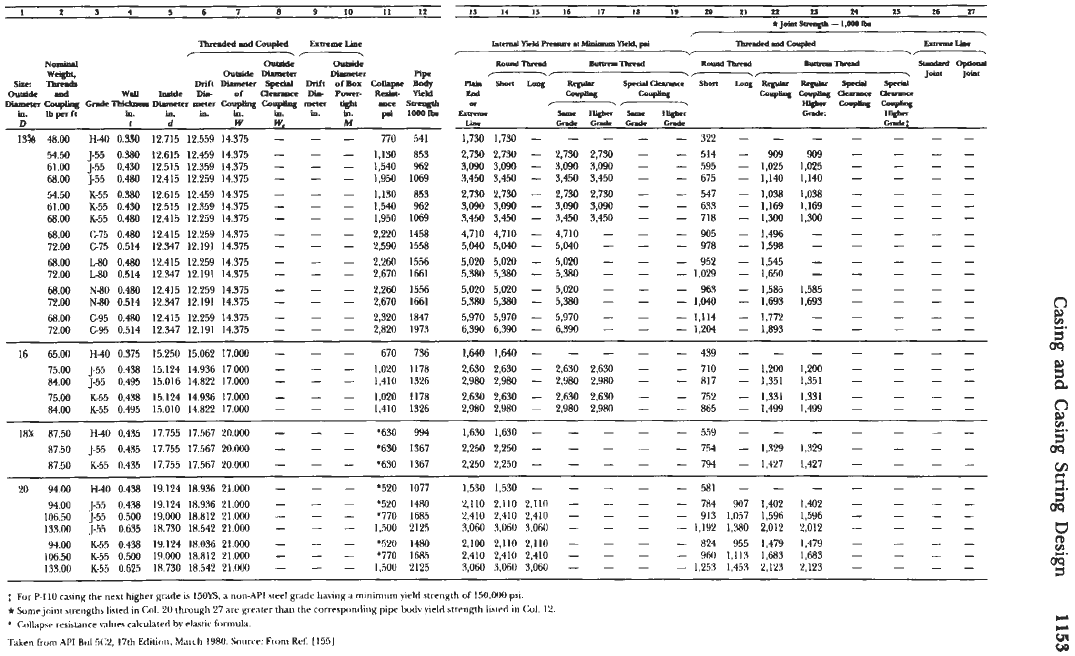
13g
4800
5450
61
00
6800
54
50
61
00
6800
68w
n00
6800
72
00
6800
7200
6800
72
00
H-W
0.330
12.715 12.559 14.375
J-55
0.430
12.515
12.359
14.375
155
0.480 12.415
12.259 14.975
J-55
0980
12.615
12.459 14.375
Ks5
OSBO
12.615
12.459
14.375
K-55
0.430
12.515
12.359
14.375
K-55
0.480
12.415
12.259 14.375
C75 0.514 12.347 12.191 14.575
(275
0.480
12.415
12.~59
14.375
u10
0.480
12.415 1z.259 14.375
~80
0.514 12.547 12.191 14.375
N80
0.480
12.415
12.259 14575
N40
0.514 12..347 12.191 14.975
G95
0.480 12.415 12.259 14.375
c95 0.514 12.547 12.191 14.375
770
1,130
1,540
1.950
i.i3n
1,540
1,950
2,220
25w
2260
2,670
2,2m
2,670
2,3211
2,8M
541
962
1069
962
1069
1458
1558
15.56
1661
1556
1661
1847
1973
855
859
1,730
2,730
3,090
3*450
2.7.W
3,090
3.450
4,710
5,040
5,020
5,980
5,020
530
6,590
5,970
1,730
2.730
3.090
3,450
2.730
3.oso
3,450
4.710
5.40
5,020
5,380
5,020
5,580
5,970
6.390
-
2.730
3.090
3,450
2,730
3.090
3,450
4,710
5,040
5,020
5,380
5.020
5,380
5,970
6.390
322
514
595
675
547
63.3
905
978
952
1.029
963
1
,40
1,114
1,204
718
-
909
is125
1,140
1
,OB
1.169
1,900
1,496
1598
1,545
1.585
1,693
1.772
1,893
1,650
16
66.00
H40
0.375
15.250
15.062
17.000
-
- -
6711
756
1,640
I,MO
- -
-
-
-
439
- -
-
-
-
- -
75.w
J-55
0.498
15.124 14.936 17.000
-
- -
1.m
1178
2,690
2,630
-
2,6sn
2,630
-
-
710
-
1,m
1,200
-
-
-
-
84.00
j.55 0.495
15.016
14.822
17.oM)
- -
-
1,410
1326
2.980 2,980
-
2.980
2.980
-
-
817
-
1,351
1.351
-
-
-
-
75.00
KS5 0.4.98
15.124 14.936
17.000
-
-
-
I,W
1178
2,630
2,630
-
2,630
2,630
-
-
752
-
1,331
1,331
- -
-
-
84.00
K-55
0,495
15.010
14.822
17.000
-
-
-
1,410
1326
2,980 2.9~0
-
2,980
2.~~0
-
-
865
-
1.499
1,499
- -
-
-
IRX
87.50
H~O
0.435 17.755 17.567 sn.000
- -
-
e630
904
1.630
1,630
- -
87.50
K-55
0.435 17.755 17.567
m.Oo0
- - -
'6x1
1367
2,2511
5,250
-
-
'm
94.00
HM
0.458 19.124 18.9% 2I.000
-
-
-
9520
1077
1,530
1.530
-
-
94.00
1-55
0.4%
19.124
18.956
zi.wn
-
-
-
'520
141w
e.no
z.iin
z.iin
-
106.50
j-55
0.500
19.~0
18.812
'~1.000
-
-
-
'770
1685
2,410 2,410
2,410
-
133.00
~5s
0.685
18.730
18.542
z1.nw
-
-
-
1,5no
2125
3,060
5,ixin
8,060
-
94.00
K-55
0.438
1y.124
1n.m
21.~0
-
-
-
wm
1480
2.100
2,110
2,110
-
106.50
K-55
O..W
19wO
IR.Rl221.000
-
-
-
'770
INIF,
2,410 2,410
2,410
-
87.50
J-55
0.455 17.755 17.567
M.000
-
-
-
*630
1367
2,250
2250
-
-
133.00
K-55
om
18
730
18.542
ZI.MN
-
-
-
1,500
2125
3,060
3.W
3,060
-
:
For
P-I10
casing
the
"ex1
higher
&e
b
Ij(Ns,
a
num-APl
steel
grade
having
a
minimum
yield
strength
of
150,wO
pi.
*
Sumrjomt
awengths
listed
in
Col
'LO
through
27
arc
greater
than
the
corwrponding
pipe
bud"
yield
srrenglh
lirlrd
in
CUI
1'L
Taken
from
API
Bul
W2,
17th
Edium.
Wnrh
IW.
Snarcc:
Fnm
Ref.
11551
*
Collap*P
rrrirlance
YalllC"
rdculalPd
by
ClaStlC
fc,mul*
-
,559
-
-
~
-
7.54
-
1,329
794
-
1,427
581
-
-
--
7R4
907
1,402
-
-
913
1,057 1,596
-
-
1,192
1.380
2,012
--
824 955
1,479
-
-
960
1.113
1,683
- -
1,253
1.453
2,125
-
--
--
-----
1,329
-
-
-
-
1,427
-
-
-
-
-----
1,405
- -
-
-
1,596
-
-
- -
2,012
-
-
-
-
1,479
- -
-
-
1.683
-
-
-
-
2,123
-
-
-
-
n
P
09
E.
r,
3
09
E.
U
D
6.
3
c
c
u1
0
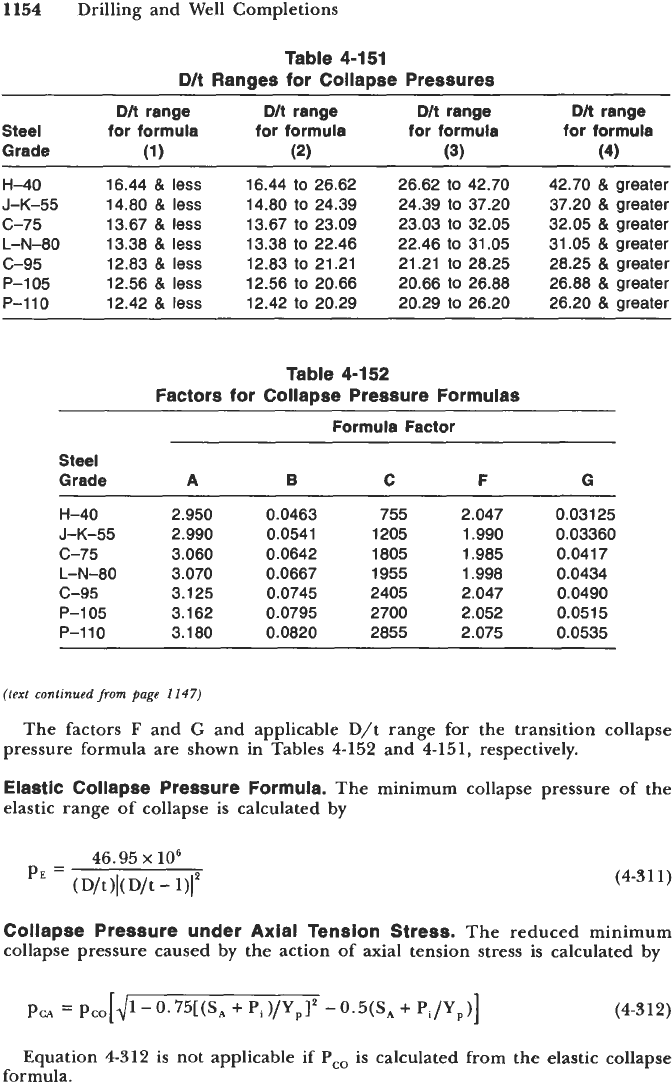
1154
Drilling and Well Completions
Table 4-151
D/t Ranges for Collapse Pressures
Dlt
range Dit range Dit range
Dlt
range
Steel for formula for formula for formula for formula
Grade
(1
1
(2)
(3)
(4)
H-40
16.44
&
less
16.44
to
26.62 26.62
to
42.70 42.70
&
greater
J-K-55 14.80
&
less
14.80
to
24.39 24.39
to
37.20 37.20
&
greater
c-75 13.67
&
less
13.67
to
23.09 23.03
to
32.05 32.05
&
greater
L-N-80
13.38
&
less
13.38
to
22.46
22.46
to
31.05 31.05
&
greater
c-95 12.83
&
less
12.83
to
21.21 21.21
to
28.25 28.25
&
greater
P-105
12.56
&
less
12.56
to
20.66
20.66
to
26.88 26.88
&
greater
P-110 12.42
&
less
12.42
to
20.29 20.29
to
26.20
26.20
&
greater
Table 4-152
Factors
for
Collapse Pressure Formulas
Formula Factor
Steel
Grade
H-40
J-K-55
c-75
L-N-80
c-95
P-105
P-110
A
2.950
2.990
3.060
3.070
3.125
3.162
3.180
B
0.0463
0.0541
0.0642
0.0667
0.0745
0.0795
0.0820
C
755
1205
1805
1955
2405
2700
2855
F
2.047
1.990
1.985
1.998
2.047
2.052
2.075
G
0.03125
0.03360
0.041 7
0.0434
0.0490
0.0515
0.0535
(text continued
from
page
1147)
The factors
F
and
G
and applicable D/t range for the transition collapse
pressure formula are shown in Tables
4-152
and
4-151,
respectively.
Elastic Collapse Pressure Formula.
The minimum collapse pressure of the
elastic range of collapse is calculated by
(4-31
1)
Collapse Pressure under Axial Tension Stress.
The reduced minimum
collapse pressure caused by the action of axial tension stress is calculated by
pa
=
p,,[,/1-0.75[(SA+Pi)/Yp]2
-0.5(SA+Pi/Yp)]
(4-3 12)
Equation
4-312
is
not applicable if
P,,
is calculated from the elastic collapse
formula.
